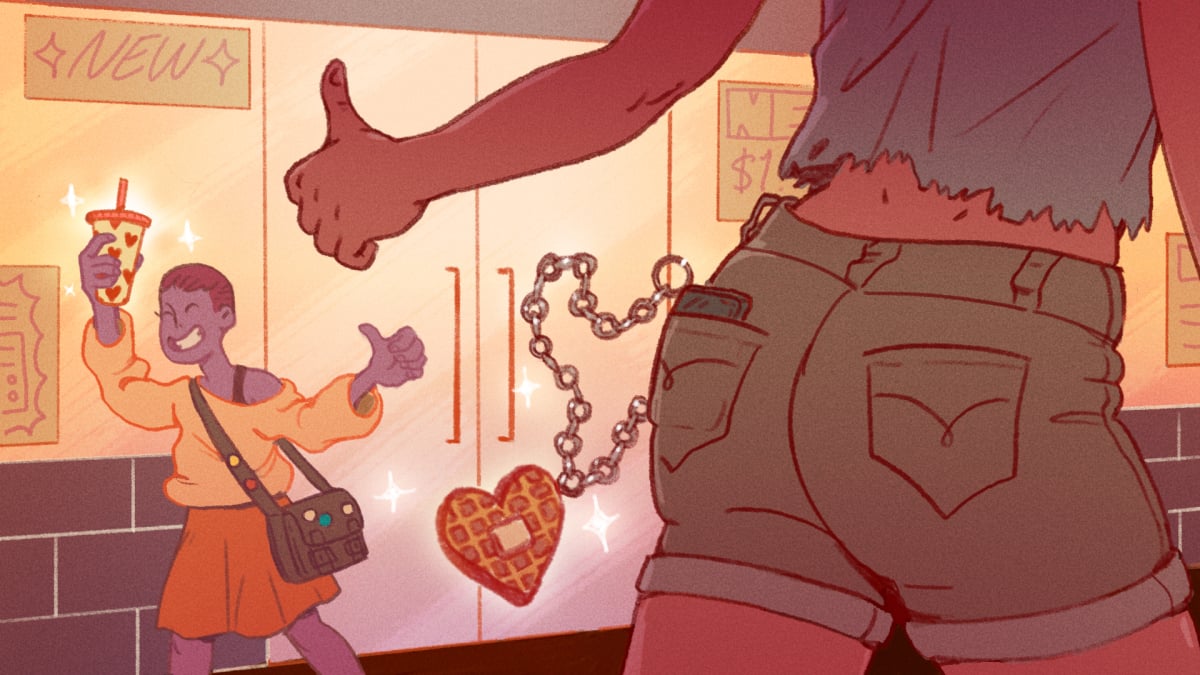Entertainment
What is subtle merch, and why is it all over TikTok?

“Run, don’t walk to Starbucks! Obscure Harry-coded cups and mugs,” reads a recent TikTok video posted by @elizatolfrey(Opens in a new tab) that’s garnered over 1.4 million views. The video then pans to mugs and thermoses decorated with images of breakfast food, and if you’re struggling to put the pieces together, that’s the point. Far from the mass-produced concert tee or branded figurine, “subtle merch” or your fave “coded” items are deeply personal to fans, often homemade, and signal a fan’s knowledge or insider status within a given fandom. In this case, it’s a familiarity with the lyrics of Styles’ song “Keep Driving,” in which he sings, “maple syrup, coffee, pancakes for two, hash brown, egg yolk, I will always love you.”
You have to be deep in the world of Styles to feel that these cups have anything to do with him — and you. But new must-have subtle merch videos like @elizatolfrey’s pop up daily, and they’re part of the changing conversation of what it means to be a fan.
If you know you know
Dr. Briony Hannell, a university teacher of Sociology at the University of Sheffield who researches fan culture, explained to Mashable that fan-made merch can signal a wide range of information to other fans, such as knowledge and interests within the fandom. Further, creating merch fosters a deeply emotional relationship between fans and “their object of fandom”; it’s a way to represent the relationship a fan feels they have with their fave. “When a fan makes subtle fan-made merchandise and gifts or sells it to other fans, they are able to pass on this personal, emotional, and embodied relationship,” said Hannell. “It can draw the dividing line between hardcore fans, fans, casual audience members, non-fans, and anti-fans.”
Think of it as like speaking a special language shared only among those who know: If someone recognizes a fan’s subtle merch, they immediately know they’re part of the club.
In her essay “Fan Labor and Feminism: Capitalizing on the Fannish Labor of Love,”(Opens in a new tab) fandom researcher Kristina Busse wrote that fannish love injects these otherwise standard items with meaning that gives them worth.
How subtle is subtle merch, really?
Madison Seifer has been a fan of Styles for 12 years but didn’t discover fan-made subtle merch until 2020, when she stumbled across the multi-fandom merch store Pressed Paper Shop(Opens in a new tab) on TikTok. The 23-year-old clinical research assistant isn’t a super showy person and appreciates that she can wear subtle merch with everyday outfits “without it being in your face.” Among her collection are “shirts that are replicas of shirts he has worn, sweaters with lyrics on them, a decal on my car of two ghosts in reference to his song on Harry Styles, and earrings from All by Lauren(Opens in a new tab) [a popular online small business that sells earrings inspired by the shop-runner’s favorite singers] that are inspired by his songs or outfits,” Seifer told Mashable. She finds fan-made merch on Etsy, Instagram, and TikTok.
It’s not just Styles fans that partake in subtle merch. Fan-made merch, which relies on a fan’s personal connection to the object of fandom, therefore making it more subtle, is key to any fandom, from Marvel to anime.
Megan Tan, a 21-year-old K-pop fan and art student in Singapore, runs Tarocoeur(Opens in a new tab), a K-pop online store that she promotes on Instagram and TikTok as well as hosting local pop-ups. Her signature items are liquid- and glitter-filled Pantone swatch keychains reminiscent of ’90s glitter wands. She has swatches for over 20 different K-pop groups(Opens in a new tab), and she also takes requests for video game and anime swatches. Each keychain features the name of the song, artist, or character it’s an homage to. “I take inspiration from music video lore, album concepts, song lyrics, etc. and interpret them using colors, textures, and vibes to capture the essence of the song, artist, or character I’m working on,” Tan explained to Mashable. “I get comments on my videos that say things along the lines of ‘idk how but that just looks so [group name]’ and that’s exactly what I aim for when I design.”
“Not everyone likes carrying their favorite K-pop boy around, Victorian locket–style.”
Growing up, the only place where Tan could buy merch was the bootleg anime and idol goods store at the mall that only had the most “soulless and tacky” items. “I just felt like I didn’t need the whole world to know who I was a fan of, so I always looked out for merch that was a little more low-key, and eventually made my own,” said Tan. “Official merch usually consists of logos and faces slapped onto various mass-produced items, and not everyone likes carrying their favorite K-pop boy around, Victorian locket–style.”
Hannell noted that official merch clearly indicates the object of fandom and serves as an advertisement for it, with the object’s name or face central to the design. Official merch is what fandom scholars call “affirmational fandom” — public, centralized, and sanctioned displays of fandom that take a literal interpretation of the object of fandom. Subtle merch, like fan fiction, is “transformational fandom” and only recognizable as merch by other fans with a similar level of knowledge and engagement in the fandom. Transformational fandom is anonymous, un-sanctioned, and decentralized. It’s where fans get creative with their interpretations, and where community is built.
It’s more than just a commodity
That’s not to say that some artists don’t excel at selling fan-oriented official merch that’s more in line with subtle merch. Seifer pointed to Taylor Swift’s Folklore cardigan as an example. The beige cardigan mass-produced by Swift’s team doesn’t say Swift’s name anywhere and is decorated with silver stars and a patch that reads, “The Folklore Album” in small print. The cardigan quickly became a sought-after item on SwiftTok, the side of TikTok where Swifties gather. This is because the Folklore cardigan operates like any successful piece of subtle merch: Those who know are “in the know” and recognize the nondescript sweater, which gives the wearer status within the Swiftie community.
In “Fans and Merchandise,”(Opens in a new tab) media researcher Avi Santo wrote that official merch is a way that media industries have tried to define fandom solely through consumerist terms. It’s an attempt to make fandom a lifestyle that fans pay corporations to have, rather than something that’s more organic and community-based. He argued that fan-made merch is a reaction to industries trying to control what merch is sold. He also asserted that to a fan, merch can represent anything tangentially related to the object of their fandom and can materially represent experiences and memories. He wrote, “fans give their consumption an inherently private and personal nature that removes the object of consumption from the logic of capitalist exchange.”
Fans argue that fan-made merch and the meaning it carries can’t be replicated by the object of fandom’s teams or outsiders trying to capitalize on a fandom’s popularity. “You have to enjoy the music or else you wouldn’t have fun creating these designs and it just wouldn’t be authentic,” Joanna Li, a 19-year-old student at Fordham University who sells BTS and BLACKPINK–inspired phone cases and sweatshirts, told Mashable.
TikTok and the fan influencer
As social media becomes more and more about self-branding, fandom has become a lifestyle, with creators who brand themselves as fans posting like any other lifestyle creator would — except the products they’re accumulating and advertising are all related to their fave. In 2017 Santo cautioned against this. He wrote, “Fandom as lifestyle doesn’t merely place greater emphasis on consumption, but on individuals using branded products as forms of self-expression and even self-promotion in order to establish their value in a reputational economy.” He goes on to say that objects, like fan-made merch, are no longer used for curation, but rather are “self-branding” opportunities. And nowhere is the culture of self-branding more insidious than on TikTok.
“Subtle merch is linked to central tensions within fan culture around who is perceived as a “good” or “real” fan and who is not — divisions that are often drawn along the lines of gender, race, sexuality, age, and class,” explained Hannell. And with the new wave of fandom on TikTok and the coinciding rise of the influencer fan, these questions are at the forefront of any fan’s mind. Subtle merch, a fandom practice based in community and love for a fan’s fave, is itself at risk of becoming a way to commodify your fandom for likes and views — which wouldn’t be very subtle at all.
-

 Entertainment6 days ago
Entertainment6 days agoSummer Movie Preview: From ‘Alien’ and ‘Furiosa’ to ‘Deadpool and Wolverine’
-

 Business7 days ago
Business7 days agoPetlibro’s new smart refrigerated wet food feeder is what your cat deserves
-

 Entertainment5 days ago
Entertainment5 days agoWhat’s on the far side of the moon? Not darkness.
-

 Business6 days ago
Business6 days agoThoma Bravo to take UK cybersecurity company Darktrace private in $5B deal
-

 Business5 days ago
Business5 days agoHow Rubrik’s IPO paid off big for Greylock VC Asheem Chandna
-

 Business5 days ago
Business5 days agoTikTok faces a ban in the US, Tesla profits drop and healthcare data leaks
-

 Business4 days ago
Business4 days agoLondon’s first defense tech hackathon brings Ukraine war closer to the city’s startups
-

 Business6 days ago
Business6 days agoZomato’s quick commerce unit Blinkit eclipses core food business in value, says Goldman Sachs




























